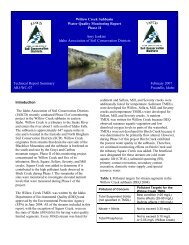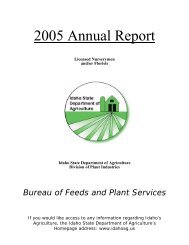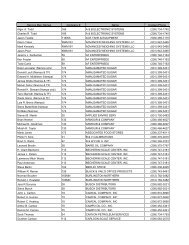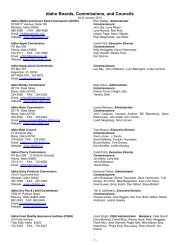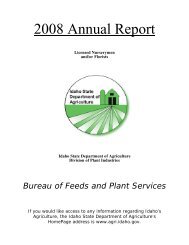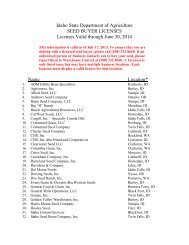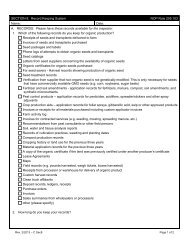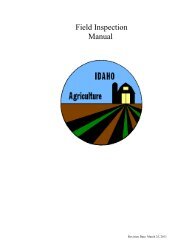2008 Statewide Strategic Plan for Eurasian Watermilfoil in Idaho
2008 Statewide Strategic Plan for Eurasian Watermilfoil in Idaho
2008 Statewide Strategic Plan for Eurasian Watermilfoil in Idaho
Create successful ePaper yourself
Turn your PDF publications into a flip-book with our unique Google optimized e-Paper software.
• Thus, due to the <strong>in</strong>terest shown by some stakeholders <strong>in</strong> <strong>Idaho</strong>, it is suggested that short<br />
term research and /or extensive literature reviews be conducted by <strong>in</strong>dependent third<br />
parties on such subjects as the effects of aeration (such as, Solar Bee's) and possible<br />
biocontrol <strong>in</strong>sects on EWM. Additional short term research projects should <strong>in</strong>clude<br />
evaluation of old and new herbicides by <strong>Idaho</strong> regulatory staff or scientists to develop<br />
expertise with<strong>in</strong> the state over a short time to allow development of optimum management<br />
programs or best management practices not only <strong>for</strong> milfoil, but also <strong>for</strong> potentially new<br />
<strong>in</strong>vasive aquatic species.<br />
• Additional applied research and demonstration projects are needed to ref<strong>in</strong>e control<br />
methodologies <strong>for</strong> <strong>Idaho</strong> waters <strong>in</strong>clud<strong>in</strong>g:<br />
o Economic impacts of <strong>in</strong>vasive aquatic plants<br />
o Current knowledge of effects of newer herbicides<br />
o Survey techniques and cont<strong>in</strong>ued survey needed<br />
o EWM hybridization issues<br />
o Comprehensive bibliography of EWM publications<br />
o Effectiveness and past extent of the use of the sterile grass carp<br />
ISDA Response: The state’s EWM Program was established to provide “on the ground” fund<strong>in</strong>g <strong>for</strong><br />
control operations. That said, there may be a need <strong>for</strong> focused and applied research to answer<br />
specific operationally-related questions. Short term projects as mentioned above do fall <strong>in</strong>to this<br />
category. ISDA concurs with this recommendation to encourage applied research and will evaluate<br />
the list provided here to determ<strong>in</strong>e applicability to the state.<br />
Issue 11.0: Lack of experienced state/county staff <strong>in</strong> aquatic weed management.<br />
<strong>Idaho</strong> has well tra<strong>in</strong>ed and experienced weed staff/county super<strong>in</strong>tendents <strong>for</strong> terrestrial weeds,<br />
but aquatic weed management is significantly different. Compared to terrestrial weed control,<br />
• Aquatic weed control is usually more costly<br />
• Public has great concern over pesticides <strong>in</strong> water<br />
• Public can contact pesticides <strong>in</strong> water<br />
• Control options are usually very limited<br />
• Visibility of plants is poor and often weeds are undetected<br />
• Identification and taxonomy of plants are difficult and often not clear<br />
• Herbicides can move off site due to various weather events<br />
• Monitor<strong>in</strong>g success or failure of treatments is much more difficult<br />
• Control failures do occur.<br />
It appears that <strong>in</strong> <strong>Idaho</strong>, there is currently more aquatic weed management experience/knowledge<br />
vested <strong>in</strong> commercial and public applicators than <strong>in</strong> state regulatory staff. Most weed control<br />
super<strong>in</strong>tendents have little experience <strong>in</strong> aquatics and all those the panel met with requested<br />
tra<strong>in</strong><strong>in</strong>g programs. The future success of the <strong>Idaho</strong> aquatic plant management program will only<br />
occur as the regional biologists and county weed personnel become better tra<strong>in</strong>ed. This lack of<br />
unbiased agency expertise has raised public concerns over the conduct and evaluation of<br />
success/failure on some of the treatment areas. Differences <strong>in</strong> op<strong>in</strong>ion also exist <strong>in</strong> some areas as<br />
to whether weeds were actually present or if the plants <strong>in</strong> question were native plants.<br />
Recommendation 11.1: Agency staff expertise<br />
Knowledgeable staff must be hired or tra<strong>in</strong>ed to assume the new responsibilities of an expanded<br />
aquatic plant management program (See Recommendation 2.2: Staff<strong>in</strong>g). There are not a large<br />
number of people with extensive aquatic weed control experience <strong>in</strong> the US with most of the<br />
71



